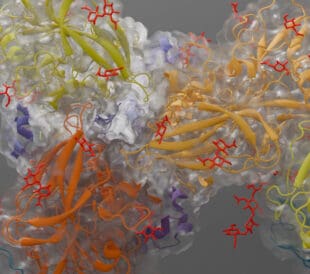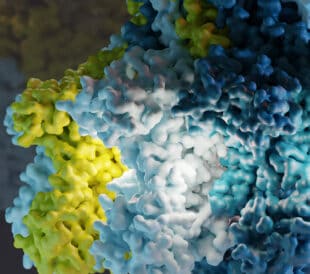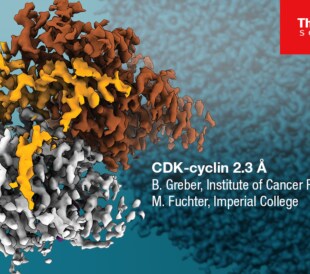2023 Cryo-EM Grant Award recipients driving life science research
Cryo-electron microscopy (cryo-EM) is an increasingly popular structural biology technique due to the exciting, vital insights it brings to researchers across the life sciences. Thermo Fisher Scientific is dedicated to offering optimized, intuitive cryo-EM technology to support this invaluable work. More than that, we understand that a strong, growing community is the only way novel techniques, like cryo-EM, can continue to progress and thrive. In support of this cryo-EM community, Thermo Fisher is proud to offer the Cryo-EM Grant Program, which provides qualifying doctoral and postdoctoral students up to $10,000 USD in products to support their life science research.
Learn more about this year’s grant award recipients and how they are using cryo-EM to advance their work.
Gold recipient ($10,000 USD): Jessica Heebner, Penn State University – College of Medicine
Research: Visual proteomics of neuronal growth cones using cryo-ET and deep learning segmentation
Jessica Heebner is a sixth-year PhD candidate in the Matt Swulius Lab at Penn State College of Medicine. The Swulius lab is leveraging cryo-electron tomography (cryo-ET) to study neuronal development. By taking snapshots of the intercellular space, they can directly visualize how neurons connect to their synaptic targets. However, such high-resolution 3D imaging produces a vast amount of data. Heebner’s work is focused on the development of image analysis and segmentation methods that can more quickly and reliably process all this data.
 |
“I really have found a passion for image analysis, specifically doing segmentation work. I would love to be in a spot where I can collaborate with tons of people, help push their research along because right now what the field really needs is better image analysis techniques so that we can analyze all of this data that we’re collecting. I want to be the person that helps drive people’s research forward.” |
|---|
Silver recipient ($7,500 USD): Siyu Chen, University of California, San Diego, Howard Hughes Medical Institute
Research: In-situ structure of WT and PD mutant LRRK2 on cellular membranes
Dr. Siyu Chen is a postdoctoral fellow in the Elizabeth Villa Lab at the University of California, San Diego, Howard Hughes Medical Institute. He completed his PhD at Northwestern University in the interdisciplinary biological sciences program, where he worked with Dr. Yuan He. His current research focuses on LRRK2, an enzyme whose disfunction is closely associated with Parkinson’s Disease. By using a combination of cryo-electron tomography and single particle analysis, he is hoping to directly visualize how LRRK2 functions in the cell and interacts with various organelles. These observations would provide a critical foundation for LRRK2’s behavior; studying LRRK2 mutations could then reveal how it’s disrupted by Parkinson’s.
 |
“Cryo-EM is really exciting because it doesn’t require a lot of materials. You don’t have to do crystallization, which is kind of a bottleneck. In the He lab, we were dealing with really complicated systems containing a lot of big proteins; it’s hard to imagine how you would crystallize them. So that’s why I kept getting excited about cryo-EM. I think it gave me a lot more freedom to explore biologically important questions.” |
|---|
Bronze recipient ($5,000 USD): Lisa Eshun-Wilson, Scripps Research Institute
Research: Uncovering the molecular mechanisms of mitochondrial proteostasis
Dr. Lisa Eshun-Wilson is a National Science Foundation postdoctoral fellow in the Gabriel Lander Lab at the Scripps Research Institute, and she completed her biochemistry PhD in the Eva Nogales Lab at University of California, Berkeley. Her postdoctoral work focuses on the inner workings of the mitochondria, particularly how an inner-membrane protein called YME1L controls and modifies proteins within the inner membrane space. Through the use of cryo-EM, she is able to capture views of this highly dynamic protein, unraveling how it is capable of highly precise protein cleavage and modification.
 |
“I’m using cryo-EM to characterize how YME1L is choosing its prey and really being able to leverage that for drug design in the long term. I think what’s very exciting with this grant is that it gives me more resources to do that. When your resources are limited, there can be pressure to be more risk averse. What I love about this grant is it’s allowing me to tackle even more challenging questions and look at more substrates.” |
|---|
We hope that showcasing these rising stars in cryo-EM research and their work helps highlight the diverse possibilities of structural biology and continues to inspire future generations of life science research.
2023 Cryo-EM Grant Award Finalists
- Rachel Cueny, University of Wisconsin-Madison
- Iman Rostami, PhD, University of Bern, Institute of Anatomy
- Emil Axell, Lund University
- Giulia Glorani, PhD, Max- Delbrück-Centrum für Molekulare Medizin
- André Alexandre Grangeia Gouveia, ITQB-NOVA
- Irwin Selvam, PhD, Stockholm University
- Qiu Yu (Judy) Huang, University of Massachusetts Chan Medical School
- Oliver Debski-Antonia, PhD, Utrecht University






Leave a Reply